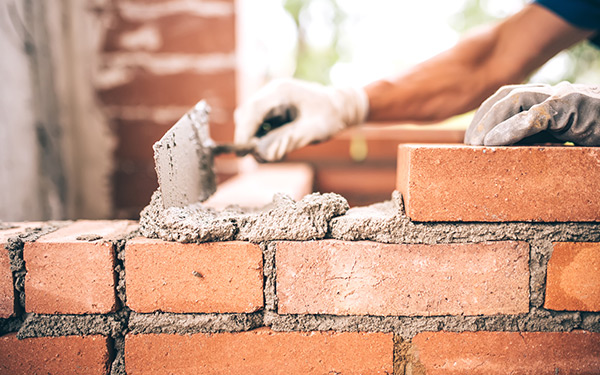Unlocking the Keys of Lasting Masonry Construction Practices for Eco-Friendly Buildings
Amongst the myriad approaches to eco-friendly building, lasting masonry building stands out as a time-tested and long lasting approach that holds a riches of untapped possibility. From the choice of materials to cutting-edge construction methods, the keys to achieving sustainability within stonework building and construction are multifaceted and fascinating.
Advantages of Lasting Stonework Building
Accepting sustainable masonry construction techniques not just minimizes ecological effect but also supplies lasting financial benefits to contractors and communities. By utilizing products like recycled blocks, blocks, and rocks, building contractors can dramatically lower the carbon footprint of their projects while advertising source effectiveness. Additionally, lasting stonework construction strategies, such as appropriate insulation and thermal mass residential properties, can improve energy performance within buildings, leading to lowered functional costs with time.
Additionally, the toughness and resilience of stonework structures add to long-lasting financial benefits. Structures built making use of sustainable masonry techniques frequently call for less upkeep and repair work, translating to cost financial savings for home builders and homeowner. The durability of stonework materials likewise ensures that structures remain steady and safe and secure, decreasing the demand for frequent restorations or substitutes.
Eco-Friendly Masonry Products
Making use of eco-friendly stonework products is an essential action towards enhancing the sustainability of construction practices and decreasing ecological effect while optimizing long-lasting economic benefits. Lasting masonry materials are sourced, generated, and made use of in a way that decreases overall ecological effect. Sustainable concrete obstructs integrate recycled aggregates and might feature improved insulation residential or commercial properties, adding to power efficiency in structures.
Moreover, natural products like adobe, rammed earth, and straw bales give exceptional thermal mass homes, reducing the demand for heating and cooling down power. These materials are usually locally readily available, advertising regional economic situations and decreasing transportation-related carbon exhausts. By picking environmentally friendly stonework materials, building and construction jobs can significantly minimize their environmental footprint and add to the development of healthier, a lot more lasting developed settings.
Energy-Efficient Masonry Strategies
Energy effectiveness plays an essential duty in enhancing the sustainability of masonry building and construction practices. By carrying out energy-efficient stonework techniques, home builders can significantly decrease the total power consumption of a building, bring about lower operational expenses and a smaller sized ecological footprint. One essential energy-efficient stonework strategy is making use of thermal mass, which involves integrating thick products like concrete or block into the building's structure to take in and keep warmth. This helps regulate indoor temperatures, minimizing the demand for mechanical home heating and cooling down systems.

Technologies in Lasting Masonry
Current developments in lasting masonry methods have produced cutting-edge methods that are reshaping the building and construction market. One such advancement is the growth of self-healing concrete, which makes use of germs installed within the concrete to recover fractures autonomously. This breakthrough not only reduces maintenance costs however additionally boosts the toughness of masonry frameworks, adding to their sustainability.
Another remarkable advancement is using recycled aggregates in masonry construction - masonry contractor. By including products such as crushed ceramic waste or recycled glass right into concrete mixes, contractors can decrease the environmental effect of building tasks while preserving structural integrity. This technique not just diverts waste from landfills however likewise conserves all-natural sources, making it a vital development in sustainable stonework building
Furthermore, the assimilation of digital layout tools, such as Building Information Modeling (BIM), is revolutionizing the means stonework structures are prepared and constructed. BIM allows for more specific estimations, decreased material wastefulness, and boosted energy effectiveness, eventually resulting in more lasting structure methods. These innovations jointly symbolize a promising future for lasting chimney services masonry building and construction in the period of environmentally friendly structures.
Future Trends in Masonry Sustainability
With the cutting-edge strides made in lasting stonework practices, the future trends in stonework sustainability are positioned to further change the building and construction sector. One of the key trends forming the future of masonry sustainability is the increased combination of modern technology. Developments such as Building Info Modeling (BIM) and online reality simulations are being made use of to enhance masonry building procedures, resulting in decreased material waste and enhanced power efficiency in buildings.
Additionally, the development of novel lasting materials is established to play a substantial duty in boosting the eco-friendliness of stonework building. masonry contractor. Technologies like self-healing concrete, recycled accumulations, and bio-based binders are acquiring grip for their capacity to lessen environmental influence while keeping architectural stability

Verdict
To conclude, lasting masonry building and construction methods offer numerous advantages for environmentally friendly structures. By making use of environmentally friendly products and energy-efficient techniques, masonry can add to a more sustainable constructed atmosphere. Innovations in sustainable stonework are constantly being established to better boost the environmental performance of buildings. Looking in the direction of the future, the fad of stonework sustainability is expected to expand, causing even more environmentally pleasant and energy-efficient building and construction practices in the years to come.